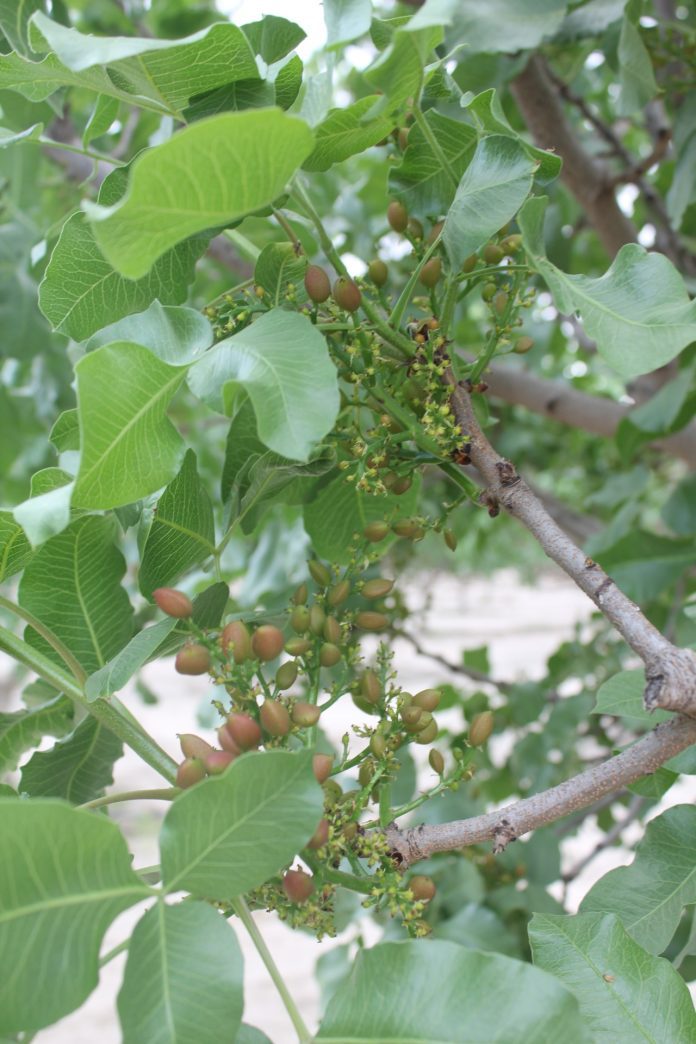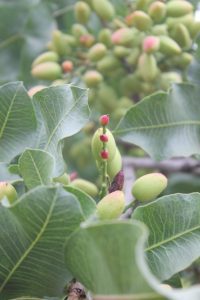
Nitrogen, potassium, boron and zinc are the four key nutrients necessary for pistachio production, but research has shown they are not always needed postharvest. Douglas Amaral, UCCE orchard advisor in Kings and Tulare counties, stressed that monitoring the levels of these nutrients in an orchard should be done annually to determine orchard needs for optimum production.
Most nutrient applications take place in the spring, when root uptake is highest, but postharvest nutrition needs should not be overlooked. Amaral noted weather, flooding and pistachio variety could direct some changes or alterations in a grower’s nutrient management plan to include postharvest nutrient application.
“Flooding that occurred this year is a concern, how it has affected nutrient availability, and it is drawing grower attention,” Amaral said. Orchards that became flooded in the winter and spring may need a soil analysis before implementing a new nutrition plan to addresses losses. And, while some important nutrients may have been flushed from the root zone, others may have increased levels in the soil due to sediment deposition, Amaral said. His current research in pistachio nutrition is also looking at possible variation in nutrient application timing and use in the varieties Golden Hills and Lost Hills, two earlier blooming pistachio varieties that are being planted in higher numbers now than the standard Kerman variety.
Amaral said that data on the Golden Hills and Lost Hills nutrition studies should be available next year.
“So far, it appears that demand is similar to that of Kerman, but no conclusions yet.” Amaral said he is conducting research on all pistachio nutrients to determine if there is any change in uptake throughout the season.
There are two main nutrient concerns in postharvest pistachio production: nitrogen and potassium. Unless there was an insufficient amount of nitrogen applied in the spring and summer or yields were overestimated, there is no need for postharvest nitrogen application. Nitrogen uptake is based on yields. Research has shown for every 28 pounds of pistachios harvested, 1,000 pounds of nitrogen is taken from the orchard.
Nitrogen
In an issue of San Joaquin Valley Trees and Vines, a UC publication, Amaral noted nitrogen, an essential for many plant processes, must be managed carefully to avoid not only losses to run off, but loss of efficiency. Maximizing yields and minimizing loss to environment makes matching N demand by tree to N supply critical for preventing economic loss.
Amaral wrote leaf sampling alone does not provide a clear picture of nitrogen needs. In January, an estimate of expected orchard yield based on historic trends and the previous year’s yield should be done. The estimate should also take into account number of chill portions thus far in the season and weather patterns. An accounting of all N sources in the orchard should be included along with leaf sample analysis.
Nitrogen application strategy should reflect the leaf, yield and soil estimates. A spring leaf sample can determine the N concentration in the leaves can be a measure of the nutrient management plan and to see if there are deficiencies or toxicities. Amaral noted that July leaf samples are too late in the season to adjust fertilization applications. He said a validated model for predicting July N levels from early season leaf samples can predict summer values. An example is a 3% N leaf sample taken 40 days after full bloom would be 2.6% in July, which is sufficient for kernel filling.
Trials done by UCCE Area Orchard Systems Advisor Katherine Jarvis Shean showed there is little to no nitrogen uptake after harvest by pistachio trees, but after an ‘on’ year, there is a recommendation that 20% of the annual nitrogen budget be applied when pistachio nuts reach maturity or shortly after harvest.
Amaral noted sufficient nitrogen is needed for tree growth and yield, but overapplication can negatively affect uptake of other nutrients. It may also result in excessive vegetative growth rather than production.

Potassium
Potassium is commonly banded in orchards in the fall, Amaral said, and it should be done no later than October. November applications are acceptable if done before a rain. This nutrient loosely binds to clay and soil organic matter, protecting the nutrient from leaching over the winter. Typical products used are potassium sulfate and potassium chloride. Bands should be made in the wetted zone in the tree row as any that fall outside will be inaccessible to the trees. This nutrient may also be applied via fertigation.
Solubility is not an issue in fall-banded applications, but it may be a consideration in fertigation. The lower the solubility of a K fertilizer, the more water is needed to dissolve it.
Zinc
UCCE Farm Advisor Phoebe Gordon wrote in San Joaquin Valley Trees and Vines that the micronutrient zinc is commonly deficient in Central Valley soils due to high pH. Foliar applications are typically done in pistachios in the spring. Soil applications are not. Reduced yield is a common sign of zinc deficiency. Symptoms in pistachio trees include interveinal chlorosis in addition to smaller leaves and extremely short internodes resulting in a rosetting effect. Gordon notes the most practical solution to a zinc deficiency is a foliar application during early spring flush.
Foliar applications of boron and zinc in pistachios are commonly done in the spring, but Amaral noted in the past, a zinc application was done in the valley mainly for defoliation. That practice is no longer recommended.
Boron
Soil-applied boron, Amaral noted, is not taken up by the trees in the fall. It has been noted in research that pistachios are boron-hungry. Gordon notes that leaf monitoring is advised to evaluate for deficiency or toxicity. Deficiency symptoms are cupped and deformed leaves, though they retain their green color. Research done by Louise Ferguson and Patrick H. Brown at UC Davis showed the best time for foliar application of boron is from the late dormant to early bud stages. Soil applications of boron are not as effective as foliar applications for supplying sufficient boron for flowering.
Tools
Amaral recommended the following tools to help pistachio growers improve their fertilization plans. The Nitrogen and Potassium Prediction Model for Pistachio provides information on leaf sampling techniques and in-season N applications. The California Fertilization Guidelines for Pistachio has recommendations for nitrogen, phosphorus and potassium, including general deficiency symptoms, soil testing and soil and foliar applications. The Pistachio Prediction Model uses nutrient analysis of spring leaf samples to predict late summer nutrient concentrations of nitrogen and potassium K.
Amaral noted these tools and guidelines have been developed specifically for the Kerman variety but are also considered useful for other pistachio varieties.

Cecilia Parsons | Associate Editor
Cecilia Parsons has lived in the Central Valley community of Ducor since 1976, covering agriculture for numerous agricultural publications over the years. She has found and nurtured many wonderful and helpful contacts in the ag community, including the UCCE advisors, allowing for news coverage that focuses on the basics of food production.
She is always on the search for new ag topics that can help growers and processors in the San Joaquin Valley improve their bottom line.
In her free time, Cecilia rides her horse, Holly in ranch versatility shows and raises registered Shetland sheep which she exhibits at county and state fairs during the summer.















